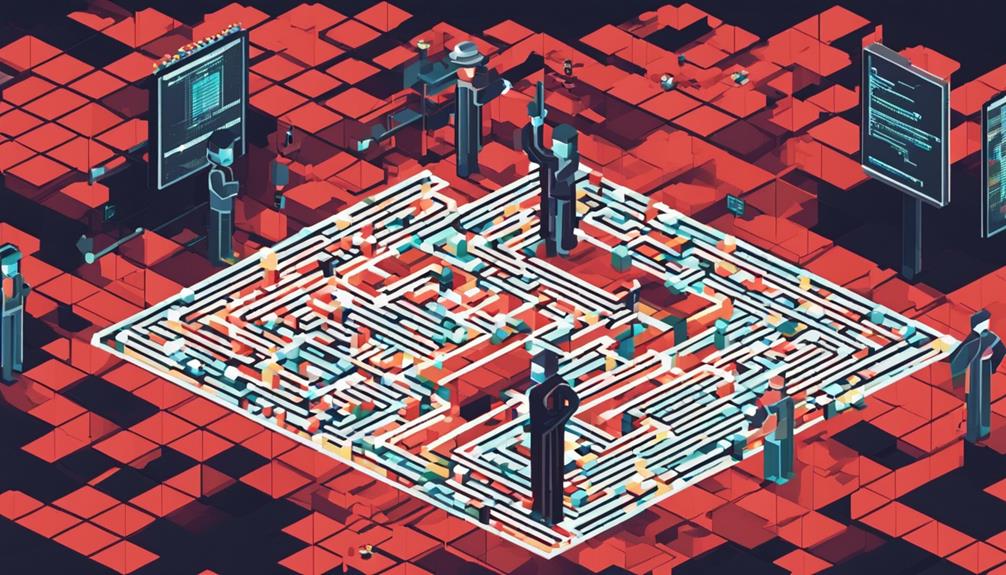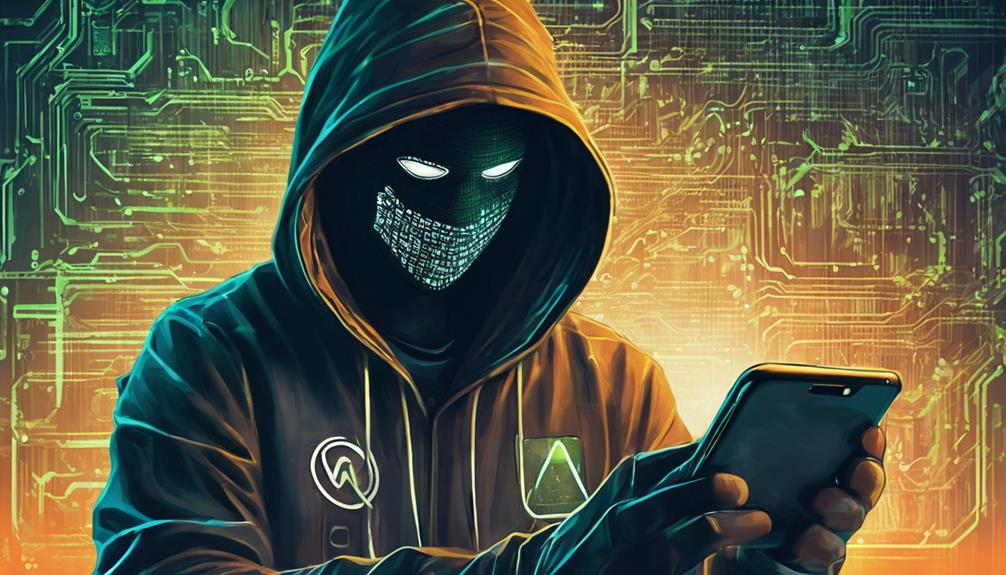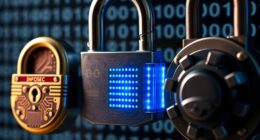Blockchain offers robust security with encryption and tamper-proof transactions, but hidden vulnerabilities exist. Private keys are prime targets for hackers seeking access to digital assets. Vulnerabilities in coding can be exploited, jeopardizing blockchain integrity. Human errors, like unsafe key handling, pose risks despite security protocols. Preventive measures include training, secure key storage, and strict access controls. Understanding private key protection is paramount for enhancing blockchain security. To uncover more about the hidden truths of blockchain safety and ways to fortify against hackers, explore the nuances of vulnerabilities and strategies outlined in the research.
Key Takeaways
- Encryption and consensus mechanisms make blockchain transactions secure.
- Private key protection is crucial to prevent unauthorized access.
- Regular code audits mitigate vulnerabilities and hacking risks.
- Understanding key storage methods enhances blockchain security.
- Secure wallets and encryption methods help safeguard against hackers.
Blockchain Security Measures
Blockchain security measures are vital components in safeguarding digital assets and maintaining the integrity of decentralized ledgers. Encrypted data plays an essential role in ensuring that transactions are secure and tamper-proof within a blockchain network.
Private keys, which are unique cryptographic keys, are used to access and manage digital assets stored on the blockchain. The security of these private keys is paramount, as unauthorized access can lead to theft and compromise of funds.
Storing private keys securely is a primary concern in blockchain security. Wallets, whether hot (online) or cold (offline), are commonly used to store private keys. Hackers often target these wallets to gain access to users' private keys and steal cryptocurrencies.
To mitigate this risk, individuals must understand different key storage methods, choose secure wallets, and regularly transfer keys to new storage devices to enhance security measures. By taking these precautions, users can better protect their digital assets from potential hacks and unauthorized access.
Vulnerabilities in Blockchain Coding

Vulnerabilities in blockchain coding present coding weaknesses that hackers can exploit, leading to security risks in blockchain systems. These exploitable vulnerabilities can stem from bugs, loopholes, and programming errors, especially in poorly implemented smart contracts.
Hackers may target flaws in blockchain consensus algorithms to manipulate transactions, highlighting the importance of regular security audits and code reviews to mitigate these risks.
Coding Weaknesses in Blockchain
Identifying and addressing coding weaknesses in blockchain systems is paramount to safeguarding digital assets and preventing unauthorized access by malicious actors. Blockchain vulnerabilities often arise due to programming errors or oversights in the code, making it essential to conduct regular code audits and implement security updates.
Poorly written smart contracts or code can introduce loopholes that hackers can exploit, leading to security breaches and unauthorized access. These coding weaknesses can have severe consequences, such as the theft of digital assets and manipulation of transactions.
To mitigate the risks associated with coding weaknesses in blockchain, developers must prioritize thorough testing, code reviews, and adherence to best practices in coding. By proactively identifying and rectifying coding vulnerabilities, blockchain systems can enhance their security posture and better protect against potential cyber threats and attacks.
Exploitable Vulnerabilities in Blockchain
Coding weaknesses in blockchain systems pose a significant risk to the security and integrity of digital assets. They can be exploited by malicious actors to manipulate transactions or steal funds. Blockchains use complex algorithms and decentralized structures to secure data, making it nearly impossible to hack the system directly. However, vulnerabilities in the code can still be targeted by hackers.
Weaknesses in the code structure or implementation can result in security breaches and unauthorized access to sensitive information. Smart contracts, a key feature of blockchain technology, can introduce vulnerabilities if not coded correctly, providing opportunities for exploitation. Bugs or loopholes in the blockchain code can compromise the entire network's integrity and security.
To mitigate these risks, regular code audits and security assessments are essential. They help identify and address vulnerabilities promptly, ensuring the continued safety of blockchain systems and digital assets.
Security Risks in Blockchain
Security risks in blockchain arise from exploitable vulnerabilities in the coding of blockchain systems. These vulnerabilities can be manipulated by malicious actors to compromise the integrity and security of digital assets. These risks can potentially expose personal information and jeopardize data protection within the blockchain network.
The intricate nature of blockchain coding, including the use of if-then statements, creates avenues for exploitation if not carefully managed. Hackers can exploit the reprogrammable characteristics of blockchain to introduce malicious code and disrupt the system's operations.
Additionally, the decentralized nature of blockchain, while offering many benefits, also means that controlling ledger updates through coding can pose significant security challenges. Ensuring robust security measures and continuously monitoring and updating the blockchain code are essential steps in mitigating these risks and safeguarding the integrity of digital assets and personal information stored within the blockchain network.
Risks of Human Errors

Human errors pose significant risks to blockchain security. Misconfigurations and oversights can lead to potential vulnerabilities. Training and awareness are vital in mitigating these risks. Individuals play a key role in maintaining the integrity of blockchain transactions.
Protecting against human error requires a thorough approach. This approach should address both technical protocols and human behavior.
Human Error Vulnerabilities
Mistakes made by individuals handling cryptocurrency keys can greatly compromise the security of blockchain systems, leaving them vulnerable to theft and exploitation by hackers. When it comes to human error vulnerabilities in blockchain security, the following points are important to take into account:
- Sending Crypto Keys Unsafely: Transferring crypto keys over unsecured networks or sharing them inadvertently can expose them to malicious actors.
- Social Engineering Attacks: Hackers often manipulate individuals to gain access to sensitive information or breach security measures in blockchain systems.
- Challenges in Data Protection: Despite network security protocols, safeguarding data from human error remains a significant obstacle in the blockchain domain.
- Indirect Targeting: Many cryptocurrency hacks involve exploiting human operators rather than directly targeting the blockchain itself, emphasizing the need for heightened awareness and education on handling crypto wallets securely.
Understanding these human error vulnerabilities is crucial in fortifying blockchain security and thwarting potential threats posed by cybercriminals.
Misconfigurations and Oversights
Given the susceptibility of blockchain systems to human errors, the risks associated with misconfigurations and oversights by operators are important in compromising the security of these networks.
Misconfigurations, such as improper settings or permissions, can create vulnerabilities that hackers exploit. Human errors, like mistakenly sharing private keys or failing to update security protocols, open doors for unauthorized access to blockchain data. Hackers often target these weak points to compromise the integrity of the network.
Safeguarding blockchain data from human error is essential to ensuring its security. It is vital for operators to be vigilant in their actions and adhere to best practices to prevent misconfigurations and oversights. Education and training on handling blockchain data can play a pivotal role in reducing the likelihood of security breaches caused by human mistakes.
Training and Awareness
Addressing the significance of proper training and awareness is crucial in mitigating the risks associated with human errors in blockchain security. Human errors, such as sending crypto keys over unsecure networks, can result in theft within blockchain security.
To combat this, organizations should focus on:
- Comprehensive Training Programs: Implementing regular training sessions to educate employees on best practices and potential risks can enhance awareness and reduce the likelihood of errors.
- Phishing Awareness Campaigns: Conducting simulated phishing attacks can help employees recognize and avoid social engineering tactics used by hackers.
- Strict Access Controls: Enforcing strict access controls and multi-factor authentication can add layers of protection against unauthorized access due to human errors.
- Continuous Monitoring: Regularly monitoring and auditing user activities within the blockchain network can help detect any anomalies or suspicious behavior promptly.
Strategies to Prevent Cyber Attacks

Understanding how private keys are stored and accessed is essential in implementing effective strategies to prevent cyber attacks on blockchain systems.
Selecting secure wallets, such as cold storage options, can greatly decrease the likelihood of hacking incidents. Utilizing commercially manufactured devices and encrypted USB thumb drives is recommended to enhance wallet security.
It is advisable to routinely check and transfer private keys to new storage devices to help reduce vulnerabilities to cyber attacks.
Educating individuals on the importance of secure key storage and guiding them on avoiding potential social engineering tactics is critical in preventing cryptocurrency theft.
By following these strategies, individuals and organizations can fortify their blockchain systems against cyber threats, safeguarding their digital assets from unauthorized access and potential breaches.
Implementing these proactive measures is essential in maintaining the integrity and security of blockchain networks.
Importance of Private Key Protection

Protection of private keys is a critical foundation for ensuring the security of blockchain systems and safeguarding digital assets from unauthorized access.
When it comes to private key protection, there are several key considerations to keep in mind:
- Essential Access: Private keys are essential for securely accessing and managing cryptocurrencies.
- Preventing Unauthorized Access: Safeguarding private keys is paramount to prevent unauthorized individuals from gaining control of digital assets.
- Risk of Loss: Loss of control over private keys can lead to irreversible loss of cryptocurrency funds, emphasizing the importance of their protection.
- Secure Storage: Utilizing secure storage methods like cold wallets can help protect private keys from being compromised by hackers, ensuring the safety of digital assets.
Ensuring Secure Blockchain Transactions

Secure blockchain transactions rely on robust encryption and consensus mechanisms to safeguard against unauthorized access and maintain the integrity of transaction history.
The encryption used in blockchain technology ensures that each block is securely linked through encrypted data, making it challenging for hackers to alter the transaction records. Manipulating a blockchain would require gaining control over more than 50% of the network's computational power, a feat that is extremely important to achieve.
One of the primary vulnerabilities in blockchain security is the storage of private keys, which are essential for Bitcoin ownership. Safeguarding access to these keys is vital to prevent unauthorized transactions.
To enhance security, individuals should understand how private keys are stored and accessed, opt for secure wallet options, and utilize encryption methods for cold storage. By implementing these measures, users can greatly reduce the risk of falling victim to crypto hacks and ensure the safety of their blockchain transactions.
Frequently Asked Questions
Can Blockchain Be Easily Hacked?
While blockchain is designed with robust security features like encryption and consensus mechanisms, vulnerabilities often arise outside of the core technology. Factors like human error or weak private key storage can still be exploited by hackers.
Is Blockchain 100% Secure?
Is blockchain 100% secure? While blockchain technology provides robust security through encryption and consensus mechanisms, external vulnerabilities like private key theft and human error can compromise its integrity. Safeguarding keys and staying vigilant are essential.
Can Blockchain Be Trusted?
Blockchain, with its foundational principles of encryption, consensus, and decentralization, instills trust by providing a secure and transparent platform for transactions. While vulnerabilities exist in peripheral services, the core blockchain technology itself is generally trustworthy.
Can You Be Tracked on the Blockchain?
Blockchain transactions are pseudonymous, allowing for a degree of anonymity. However, transaction patterns and metadata analysis can potentially reveal a user's identity. Privacy-focused cryptocurrencies like Monero and Zcash offer enhanced privacy features to mitigate tracking risks.
Conclusion
To sum up, blockchain security measures must be implemented to protect against vulnerabilities in coding and human errors. Preventing cyber attacks requires strategies such as private key protection and ensuring secure transactions.
By prioritizing these measures, the blockchain can remain safe from hackers and maintain its integrity. Security is paramount in the digital age, and vigilance is key to safeguarding sensitive information and maintaining trust in the blockchain system.









